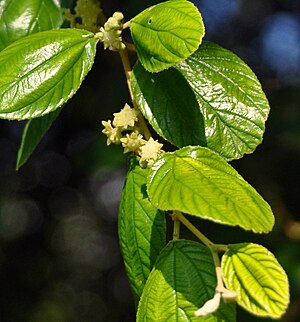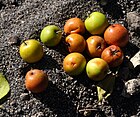Note: This is a project under development. The articles on this wiki are just being initiated and broadly incomplete. You can Help creating new pages.
Ziziphus mauritiana - Common jujube
Badarah is a much branched thorny tree that grows in the drier parts of India. The fruits are enjoyed by animals and man alike.
Uses
Relieves constipation, Relieves excessive thirst, Improves digestion strength, Nasal bleeding, Gastric, Blood disorders, Diarrhea [1]
Parts Used
Chemical Composition
Common names
| Language | Common name |
|---|---|
| Kannada | bore, elachi, elanji, yalaci, badari, bare, bari, barihannu |
| Hindi | bara-bor, ber, kath ber, |
| Malayalam | lanta, ilantappalam, lantappalam |
| Tamil | ilandai, elandai |
| Telugu | regi, regu-pandu |
| Marathi | NA |
| Gujarathi | NA |
| Punjabi | NA |
| Kashmiri | NA |
| Sanskrit | Karkandhu, kola, ahapriya, sauveera, gudaphala, baleshta |
| English | Indian Jujube |
Properties
Reference: Dravya - Substance, Rasa - Taste, Guna - Qualities, Veerya - Potency, Vipaka - Post-digesion effect, Karma - Pharmacological activity, Prabhava - Therepeutics.
Dravya
Rasa
Madhura (Sweet), Amla (Sour)
Guna
Guru (Heavy), Snigdha (Oily)
Veerya
Sheeta (Cold)
Vipaka
Karma
Kapha, Pitta, Vata
Prabhava
Habit
Identification
Leaf
| Kind | Shape | Feature |
|---|---|---|
| Simple | Alternate | distichous; stipular spines solitary or in pairs, straight or one of them recurved; nodes slightly enlarged around the leaf scars; petiole 4-8 mm, stout; lamina 1.5-4 x 1.5-3 cm, ovate, elliptic-ovate, elliptic-orbicular or suborbicular, base oblique, subcordate or round, apex round and retuse, margin glandular-denticulate or serrate, glabrous above, coriaceous, strongly 3-ribbed from base, convergent; lateral nerves 2-3 pairs, pinnate, prominent, slender, intercostae obscure. |
Flower
| Type | Size | Color and composition | Stamen | More information |
|---|---|---|---|---|
| Axillary cyme | bisexual | Greenish-yellow | 5 | n 15-20 flowered dense cymose axillary fascicles; peduncle much reduced; calyx tube 0.5 mm, woolly outside, glabrous within; lobes 5, triangular, prominently keeled on inner face; petals 5, cucullate, round at apex, deflexed with the stamens; disc 10-lobed, grooved; stamens 5, enclosed in the petals, not exserted beyond them; filaments slightly dilated at base; ovary embedded in disc, 2-celled; ovule 1, ascending; styles 2, connate to the middle; stigma 2-fid. |
Fruit
| Type | Size | Mass | Appearance | Seeds | More information |
|---|---|---|---|---|---|
| Drupe | 1 x 0.5 cm | oblong-globose, yellow or orange when ripe; 1-2-celled | seeds 1 or 2, compressed. | {{{6}}} |
Other features
List of Ayurvedic medicine in which the herb is used
Where to get the saplings
Mode of Propagation
How to plant/cultivate
Season to grow
Soil type
Propagation
Commonly seen growing in areas
Photo Gallery
References
External Links
Categories:
- Ayurvedic Herbs known to be helpful to treat Relieves constipation
- Ayurvedic Herbs known to be helpful to treat Relieves excessive thirst
- Ayurvedic Herbs known to be helpful to treat Improves digestion strength
- Ayurvedic Herbs known to be helpful to treat Nasal bleeding
- Ayurvedic Herbs known to be helpful to treat Gastric
- Ayurvedic Herbs known to be helpful to treat Blood disorders
- Ayurvedic Herbs known to be helpful to treat Diarrhea
- Herbs with Leaves used in medicine
- Herbs with Roots used in medicine
- Herbs with Fruits used in medicine
- Herbs with common name in Kannada
- Herbs with common name in Hindi
- Herbs with common name in Malayalam
- Herbs with common name in Tamil
- Herbs with common name in Telugu
- Herbs with common name in Sanskrit
- Herbs with common name in English
- Habit - Tree
- Index of Plants which can be propagated by Seeds
- Herbs that are commonly seen in the region of Tropical area
- Herbs that are commonly seen in the region of Dry deciduous forests
- Herbs
- Rhamnaceae
- Ayurvedic herbs that don't have seed photos





